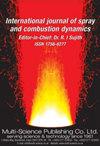Response of a swirl flame to inertial waves
IF 2.1
4区 工程技术
Q3 ENGINEERING, MECHANICAL
International Journal of Spray and Combustion Dynamics
Pub Date : 2018-12-01
DOI:10.1177/1756827717747201
引用次数: 10
Abstract
Acoustic waves passing through a swirler generate inertial waves in rotating flow. In the present study, the response of a premixed flame to an inertial wave is scrutinized, with emphasis on the fundamental fluid-dynamic and flame-kinematic interaction mechanism. The analysis relies on linearized reactive flow equations, with a two-part solution strategy implemented in a finite element framework: Firstly, the steady state, low-Mach number, Navier–Stokes equations with Arrhenius type one-step reaction mechanism are solved by Newton’s method. The flame impulse response is then computed by transient solution of the analytically linearized reactive flow equations in the time domain, with mean flow quantities provided by the steady-state solution. The corresponding flame transfer function is retrieved by fitting a finite impulse response model. This approach is validated against experiments for a perfectly premixed, lean, methane-air Bunsen flame, and then applied to a laminar swirling flame. This academic case serves to investigate in a generic manner the impact of an inertial wave on the flame response. The structure of the inertial wave is characterized by modal decomposition. It is shown that axial and radial velocity fluctuations related to the eigenmodes of the inertial wave dominate the flame front modulations. The dispersive nature of the eigenmodes plays an important role in the flame response.旋涡火焰对惯性波的响应
声波通过旋流器时在旋转流体中产生惯性波。在本研究中,仔细研究了预混火焰对惯性波的响应,重点研究了基本的流体动力学和火焰-运动相互作用机制。该分析采用线性化反应流方程,在有限元框架下采用两部分求解策略:首先,采用牛顿法求解具有Arrhenius型一步反应机理的稳态低马赫数Navier-Stokes方程;火焰脉冲响应由解析线性化反应流方程的时域瞬态解计算,平均流量由稳态解提供。通过拟合有限脉冲响应模型得到相应的火焰传递函数。这种方法是通过实验验证的完美预混,精益,甲烷-空气本生火焰,然后应用于层流旋转火焰。这一学术案例以一种通用的方式研究了惯性波对火焰响应的影响。惯性波的结构用模态分解来表征。结果表明,与惯性波特征模态有关的轴向和径向速度波动主导了火焰前调制。特征模态的色散特性在火焰响应中起着重要的作用。
本文章由计算机程序翻译,如有差异,请以英文原文为准。
求助全文
约1分钟内获得全文
求助全文
来源期刊

International Journal of Spray and Combustion Dynamics
THERMODYNAMICS-ENGINEERING, MECHANICAL
CiteScore
2.20
自引率
12.50%
发文量
21
审稿时长
>12 weeks
期刊介绍:
International Journal of Spray and Combustion Dynamics is a peer-reviewed open access journal on fundamental and applied research in combustion and spray dynamics. Fundamental topics include advances in understanding unsteady combustion, combustion instability and noise, flame-acoustic interaction and its active and passive control, duct acoustics...
 求助内容:
求助内容: 应助结果提醒方式:
应助结果提醒方式:


